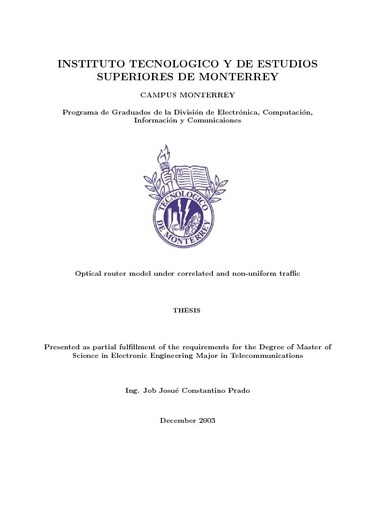| dc.creator | Constantino Prado, Job Josué | |
| dc.date.accessioned | 2015-08-17T10:40:01Z | en |
| dc.date.available | 2015-08-17T10:40:01Z | en |
| dc.date.issued | 2003-12-01 | |
| dc.identifier.uri | http://hdl.handle.net/11285/570253 | en |
| dc.description.abstract | A detailed analytical traffic model for all-optical wavelength division multiplexing (WDM) photonic packet-switched router is presented and the requirements for buffer size are analyzed. Also it is known that due to the topology, packets may generate traffic bottlenecks produced by a tendency of the routing scheme to send packets with different destinations through preferred paths. This effect increases the traffic load and, hence, the probability of blocking at the output links of specific routers in the network and, therefore, a large buffer depth is required or an increment in the number of fibers per link. Furthermore, the relationship between traffic features at optical level and node modelling is addressed in order to outline analytical models to assess node performance. An analytical representation of traffic correlation, alongside with forwarding and buffering at switching nodes is discussed in order to support performance assessments such as packet loss probability. The statistical features, e.g. marginal distribution and correlation structure, of traffic reaching an output buffer in a time-slotted photonic packet switching node is investigated. Packet arrival patterns are generated through a well-known on-off analytical model with short-range dependence that accounts for packet forwarding as well. The purpose here is to find out how far the analytical model is from representing relevant characteristics present in self-similar traffic traces. An approach is proposed for modelling buffers under bursty traffic. Finally, is given a model for optical router with non-balanced input/output and correlated bursty traffic. | |
| dc.language | eng | |
| dc.publisher | Instituto Tecnológico y de Estudios Superiores de Monterrey | |
| dc.rights | info:eu-repo/semantics/openAccess | |
| dc.rights.uri | http://creativecommons.org/licenses/by-nc-nd/4.0 | * |
| dc.subject.classification | Area::INGENIERÍA Y TECNOLOGÍA::CIENCIAS TECNOLÓGICAS::TECNOLOGÍA DE LAS TELECOMUNICACIONES | es_MX |
| dc.title | Optical router model under correlated and non-uniform traffic | en |
| dc.type | Tesis de maestría | |
| dc.contributor.department | ITESM | en |
| dc.contributor.committeemember | Castañón, Gerardo | es |
| dc.contributor.committeemember | Vargas Rosales, César | es |
| dc.contributor.committeemember | Nolazco, Juan | es |
| refterms.dateFOA | 2018-03-06T22:09:53Z | |
| refterms.dateFOA | 2018-03-06T22:09:53Z | |
| html.description.abstract | A detailed analytical traffic model for all-optical wavelength division multiplexing (WDM) photonic packet-switched router is presented and the requirements for buffer size are analyzed. Also it is known that due to the topology, packets may generate traffic bottlenecks produced by a tendency of the routing scheme to send packets with different destinations through preferred paths. This effect increases the traffic load and, hence, the probability of blocking at the output links of specific routers in the network and, therefore, a large buffer depth is required or an increment in the number of fibers per link. Furthermore, the relationship between traffic features at optical level and node modelling is addressed in order to outline analytical models to assess node performance. An analytical representation of traffic correlation, alongside with forwarding and buffering at switching nodes is discussed in order to support performance assessments such as packet loss probability. The statistical features, e.g. marginal distribution and correlation structure, of traffic reaching an output buffer in a time-slotted photonic packet switching node is investigated. Packet arrival patterns are generated through a well-known on-off analytical model with short-range dependence that accounts for packet forwarding as well. The purpose here is to find out how far the analytical model is from representing relevant characteristics present in self-similar traffic traces. An approach is proposed for modelling buffers under bursty traffic. Finally, is given a model for optical router with non-balanced input/output and correlated bursty traffic. | |
| dc.identificator | Campo||7||33||3325 | |


